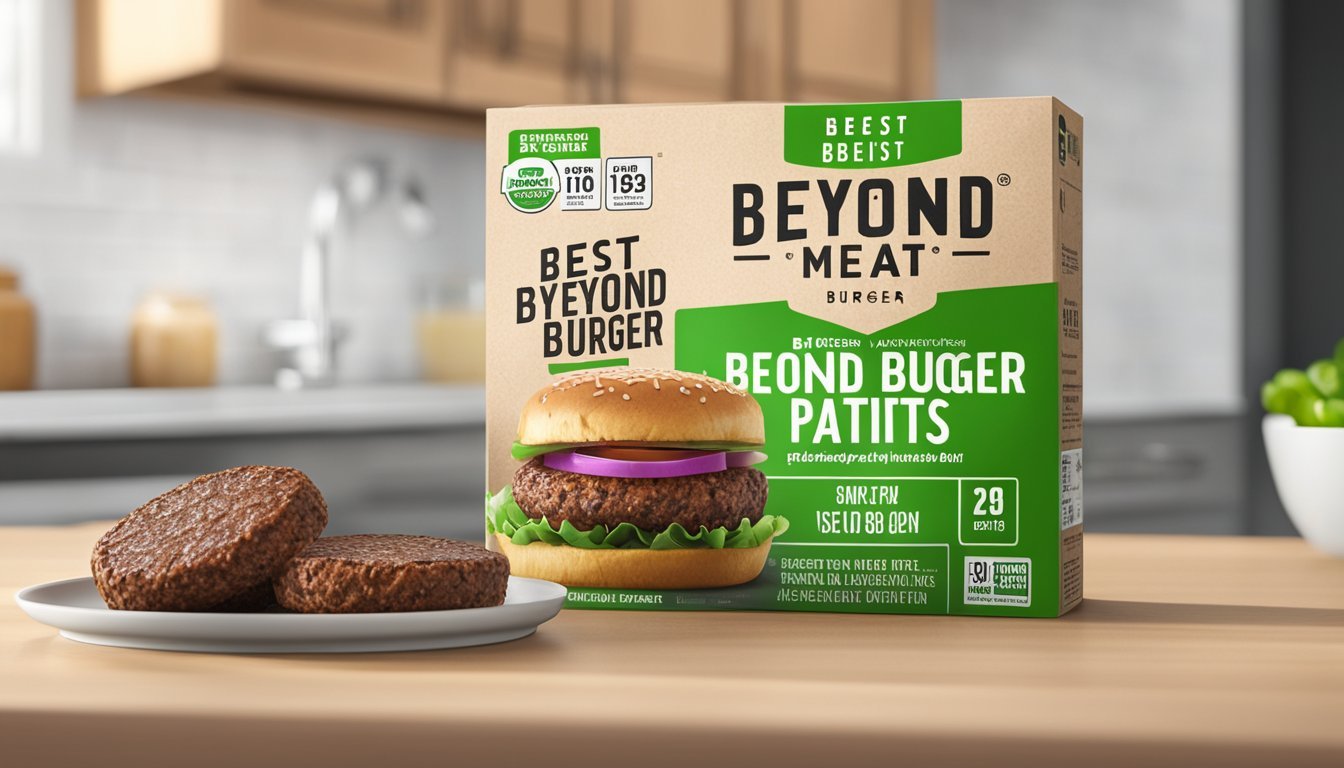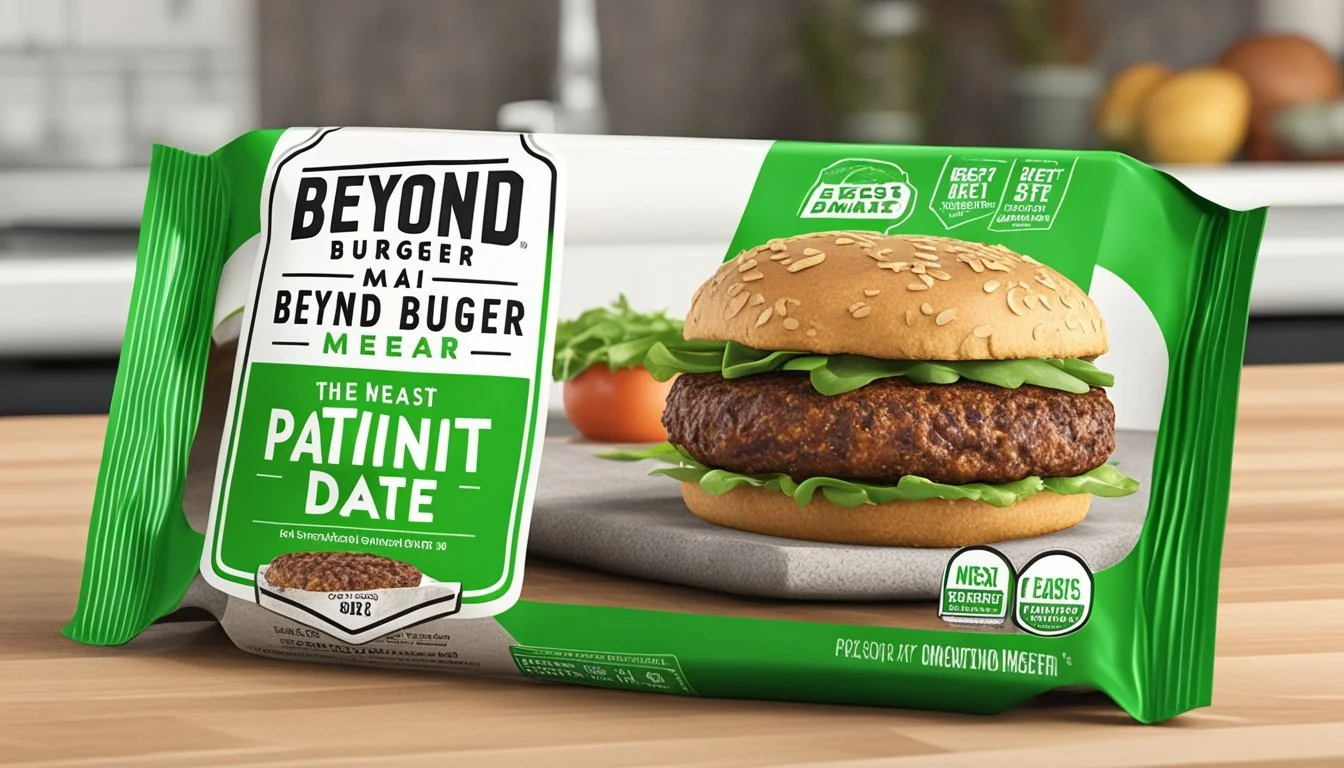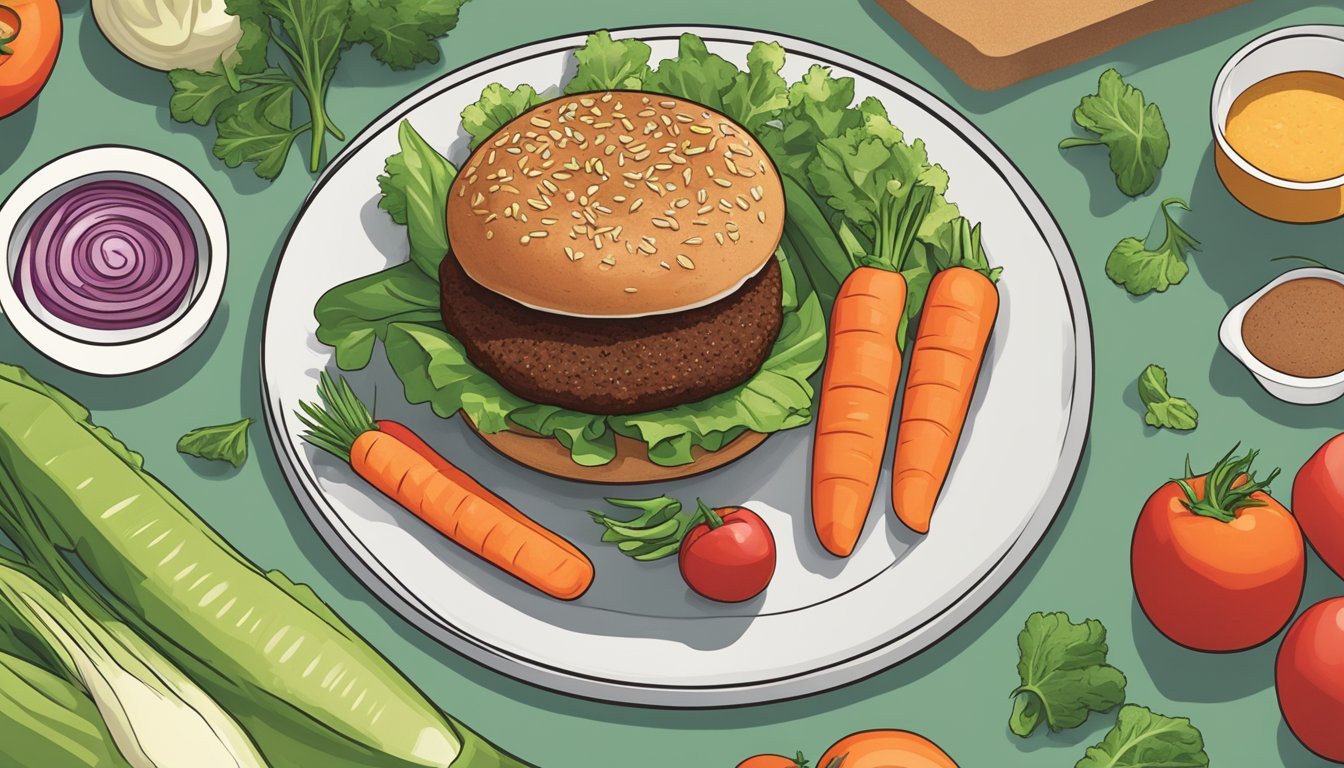How Long Does Beyond Meat Beyond Burger Plant-Based Patties Last?
Understanding Shelf Life and Storage
The Beyond Meat Beyond Burger is a popular choice among those seeking plant-based alternatives to traditional meat products. As a vegan patty designed to emulate the taste and texture of beef, this meat substitute offers nutritional benefits, including 20 grams of plant-based protein per serving, while sidestepping ingredients like GMOs, soy, and gluten. It offers an option for consumers looking to reduce their meat consumption without sacrificing the experience of enjoying a burger.
Like all perishable foods, Beyond Burger patties have a finite shelf life, which raises questions about storage and freshness. Their shelf life is influenced by various factors, including how they are stored before and after cooking. Typically, an unopened package of Beyond Meat Beyond Burger should be consumed by the 'best before' date indicated on the package for optimal quality.
For those who have prepared Beyond Burgers, proper storage in the refrigerator is key to maintaining their freshness. After cooking, the patties should be cooled and then stored in the refrigerator. It is advisable to consume them within three days to ensure safety and prevent the risk of foodborne illness. Understanding the shelf life of these plant-based patties is crucial for consumers who prioritize both health and sustainability in their dietary choices.
Understanding Plant-Based Burgers
Plant-based burgers, such as those offered by Beyond Meat, are part of a rapidly evolving category of food designed for both vegan and vegetarian diets, as well as for meat-eaters looking for alternative sources of protein. These burgers aim to emulate the taste, texture, and cooking experience of traditional beef patties while offering nutritional and environmental benefits.
The primary ingredients in Beyond Meat's Beyond Burger include proteins extracted from plants, typically peas, which contribute to the product's high protein content. They pride themselves on offering burgers that are non-GMO and free from soy and gluten, addressing common health and diet concerns.
Key Features Beyond Burger Protein Source Peas Gluten-Free Yes Soy-Free Yes Non-GMO Yes
Nutrition plays a significant role in the development of these products. Beyond Meat burgers offer a substantial amount of protein, comparable to that found in beef, fulfilling a vital macronutrient requirement. In essence, these plant-based meat alternatives are designed to not only satisfy taste buds but also to support a balanced diet.
The impact of plant-based diets on health continues to be a topic of research. However, products like the Beyond Burger provide a way for consumers to diversify their protein sources and reduce their consumption of animal products, which can be part of a strategy for improving overall health and wellness.
Product Overview
In this section, we'll detail what sets the Beyond Burger apart, its nutritional makeup, and a comparative look at its closest competitor.
Key Features of Beyond Burger
The Beyond Burger is distinguished by its plant-based composition, aiming to emulate the taste and texture of a traditional beef burger. It contains 20 grams of protein per serving, primarily from peas, mung beans, and brown rice, catering to consumers seeking a meat alternative that's soy and gluten-free. Noteworthy is that Beyond Burger patties are GMO-free and designed to suit a variety of dietary needs.
Nutritional Content
Each Beyond Burger patty packs substantial nutritional value:
Protein: It provides 20g, an impressive amount for a plant-based product.
Calories: A single patty typically contains around 230 calories.
Fat: Fat content is significant at 14g per patty, with 5g being saturated fat.
Carbs: A modest 3g of carbohydrates is contained, aiding those on lower carb diets.
Fiber: With 2g of fiber, it contributes to daily dietary fiber intake.
Cholesterol: The patties are cholesterol-free, making them a heart-friendly option.
Iron & Zinc: They provide these essential minerals, contributing to one's daily intake.
Vitamins: Vitamin B12 is included, an important nutrient often lacking in plant-based diets.
Beyond Meat Vs. Impossible Foods
The competition between Beyond Meat and Impossible Foods is tight, with both companies vying for dominance in the plant-based burger market. Here’s a brief comparison:
Protein Sources: While Beyond Meat uses peas, mung beans, and rice for protein, Impossible Foods incorporates soy and potato protein in its burgers.
Main Ingredient: Beyond Burger incorporates pea protein isolate as a key ingredient, contrasting with Impossible Foods' use of soy leghemoglobin, responsible for the 'bleeding' characteristic in their patties.
Nutritional Profile: Both offer a similar range of vitamins and minerals, with variations in fat and calorie content that may influence consumer choice based on dietary goals.
Culinary Experience: Although both aim to replicate the sensory experience of beef, their taste and texture profiles may differ, leading consumers to have a preference for one over the other based on personal taste.
The Beyond Burger's unique proposition lies in its meticulous recreation of a meat patty's juiciness and flavor while leveraging plant-based ingredients that offer nutritional benefits and cater to a broad audience, including those who abstain from soy and gluten.
Storage Guidelines
Beyond Meat Beyond Burger plant-based patties have specific storage guidelines to preserve freshness and prevent foodborne illness. Following proper refrigeration and freezing protocols ensures the patties remain safe and edible.
Refrigeration and Shelf Life
After purchase, one should store Beyond Burger patties in the fridge. Unopened, they can be refrigerated until the expire date printed on the packaging. Once opened, it is recommended to consume the patties within 3 days to prevent spoilage. For cooked Beyond Meat, it's safest to consume it within 3 days and stored in an airtight container to maintain quality and reduce the risk of bacterial growth.
Unopened: Consume by expiration date
Opened: 3 days
Cooked Beyond Meat: 3 days
Freezer Storage and Defrosting
Freezer storage extends a product's shelf life significantly. Beyond Burger patties can be frozen for about 273 days—providing they are kept at a consistent, freezing temperature. When thawing frozen patties, it is best to place them in the fridge and allow them to thaw gradually; this can take about 24 hours. Refreezing thawed patties is not recommended, as it can affect the texture and potentially increase the risk of foodborne illness.
Freezer shelf life: Up to 273 days
Thawing in fridge: 24 hours
Refreezing not recommended
Signs of Spoilage
It is crucial to be aware of the signs of spoilage to prevent consuming compromised products. One should observe the patties for any off-putting smell, mold, or a bloated package, which are all clear indicators that the Beyond Burger patties should not be consumed. Additionally, if the texture or color of the patties has noticeably changed, they should be discarded.
Smell: Sour or unusual odors
Mold: Any visible fungal growth
Packaging: Bloated or damaged package
Texture & Color: Significant changes
Cooking and Preparation
When preparing Beyond Meat Beyond Burger plant-based patties, one should focus on achieving a desirable taste and texture similar to traditional meat patties. Cooking them properly is key, along with integrating them into recipes that highlight their plant-based qualities.
How to Cook Beyond Burgers
To cook Beyond Burgers at home, heat a skillet over medium-high heat and lightly coat it with olive oil or coconut oil. Place the patties in the skillet and cook them for about 3 minutes per side. Proper cooking ensures the patties develop a browned exterior that resembles the marbling effect of beef. Another method involves preheating the oven to 400°F, placing the burgers on a baking tray lined with parchment paper, and cooking them for 10-15 minutes, flipping halfway through.
In the skillet:
Heat: Medium-high
Oil: Olive or coconut
Duration: Approx. 3 minutes each side
In the oven:
Temperature: 400°F
Surface: Baking tray with parchment paper
Duration: 10-15 minutes with a flip halfway
Recipe Ideas and Serving Suggestions
Beyond Burgers are versatile and can be included in various recipes. For a simple meal, serve them with a side of brown rice or quinoa for a complete protein combination. For added richness, consider creating burgers that have coconut oil or plant-based cheese, which complements the burger's flavors and adds to the overall mouthfeel. Utilizing heat and pressure in cooking methods can enhance the patties' texture, making them an ideal centerpiece for any plant-based meal.
Health and Nutrition Considerations
When evaluating the health and nutritional profile of Beyond Meat's Beyond Burger, it is critical to consider how these plant-based patties compare to traditional animal proteins and to understand their overall dietary benefits and potential concerns.
Comparing Beyond Burgers with Animal Proteins
Beyond Meat’s Beyond Burgers offer a plant-based alternative to traditional animal protein sources, predominantly aiming to emulate the taste and texture of beef. A typical Beyond Burger contains about 20 grams of plant-based protein, often derived from peas, which is similar to the protein content in traditional beef burgers. Unlike beef burgers, Beyond Burgers avoid cholesterol, a contributing factor to heart disease. However, they contain higher levels of sodium, which consumers often need to manage carefully in a heart-healthy diet.
Dietary Benefits and Concerns
For individuals following a vegan or vegetarian lifestyle, the Beyond Burger provides a viable source of protein that aligns with their dietary restrictions, missing from animal products. The patties also contain essential vitamins and minerals, enriching the diet with nutrients necessary for health. Despite these benefits, there are concerns among health-conscious consumers primarily due to their processed nature and sodium content. One should consider these factors when integrating plant-based meats like the Beyond Burger into a balanced diet focused on health and nutrition.
Consumer Information
In this section, consumers will find detailed responses to their frequently asked questions, ways to receive the latest updates and offers from Beyond Meat, and information regarding the company's privacy policy.
Answers to Common Questions
Q: How long can I keep Beyond Burger patties after cooking? A: Cooked Beyond Burger patties should be consumed within 3 days when stored in the refrigerator.
Q: Should I be concerned about any common allergens? A: Beyond Burger patties are free from GMOs, soy, and gluten.
Q: How do I check if my Beyond Burger patties are still good to eat? A: Signs of spoilage include an off smell, discolored appearance, and a slimy texture.
Updates and Offers
Sign Up for Updates: Individuals interested in staying informed about Beyond Meat can sign up for updates and offers:
Provide your email address through the sign-up form on the website.
Receive information about new products, company news, and exclusive promotions.
Opt-Out: Users can opt-out from communications at any time by:
Clicking the 'unsubscribe' link in the email.
Updating preferences in the account settings.
Company's Privacy Policy
Research and Privacy: Beyond Meat values consumer privacy and only collects information necessary for:
Providing personalized offers and updates.
Conducting market research to improve products and services.
Privacy Policy: The company details its use of personal data in its privacy policy:
Transparency about data collection and usage.
Commitment to safeguarding consumer information.
To review the complete privacy policy, consumers should visit the Beyond Meat official website.
Environmental and Ethical Impact
The shift to plant-based meats such as Beyond Meat's Beyond Burger reflects a growing awareness of environmental sustainability and ethical considerations among consumers. This section explores the tangible benefits of plant-based alternatives in contrast to traditional animal proteins.
Sustainability of Plant-Based Meats
Environmental Benefits:
Greenhouse Gas Emissions: Studies, including those mentioned in the Beyond Meat environmental reports, indicate that plant-based meats emit significantly fewer greenhouse gases than animal-based meats. For instance, the Beyond Burger reportedly generates 90% less greenhouse gas emissions compared to U.S. beef patties.
Resource Efficiency: The production of plant-based meats like Beyond Burgers requires less energy, land, and water. Reports show that Beyond Meat products consume approximately 6.1 MJ of energy and use 1.1 liters of water per unit, which is far less than that required for beef production.
Comparison Table: Beyond Burger vs. Beef Patty
Impact Category Beyond Burger Beef Patty GHG Emissions (Kg CO2e) 0.4 3.7 Energy Use (MJ) 6.1 11.4 Land Use (M2a eq.) 0.3 3.8 Water Use (Liter eq.) 1.1 218.4
Ethical Considerations for Consumers
Animal Welfare:
Choosing plant-based products like Beyond Burgers can align with ethical stances on animal welfare, reducing demand for animal protein sources such as red meat and poultry.
Dietary Choices:
The vegan and vegetarian movements advocate for plant-based diets, which exclude animal products, on the grounds of ethics and health. Products like the Beyond Burger provide viable alternatives that satisfy dietary preferences and ethical considerations simultaneously.
In summary, the Beyond Burger and similar products offer a more environmentally friendly and ethically considerate choice for those looking to reduce their impact on the planet and animal welfare.
Market Presence and Availability
Beyond Meat® has established a significant presence in the food industry with its Beyond Burger™. These plant-based patties, designed to appeal not only to those seeking a meat alternative but also to meat-eaters interested in diversifying their dietary choices, are crafted to be free from gluten and nuts, making them suitable for a variety of consumers.
Retail Outlets and Restaurant Partnerships
Retail: Beyond Burgers can be found on store shelves across a multitude of retail outlets. They span from local grocery stores to large supermarket chains, reflecting a robust distribution network.
Major Retailers:
Whole Foods Market
Kroger
Safeway
Restaurants: Beyond Meat has formed alliances with various restaurant chains, expanding the availability of Beyond Burgers in the foodservice sector. Notably, McDonald's tested the McPlant burger, a collaboration involving a Beyond Meat patty, but the pilot concluded without plans for permanent menu inclusion.
Restaurant Partners:
Burger King (serves a competitor, the Impossible Whopper)
Subway
Carl's Jr.
Consumer Demand and Trends
Demand: The demand for plant-based burgers, such as the Beyond Burger, has seen fluctuations. Despite previous years of growth, consumer demand patterns have adjusted due to various factors, including market saturation and consumer preferences.
Trends: Trends indicate a rise in health consciousness among consumers, who are now more scrutinizing of product contents such as total fat and other nutritional aspects. Beyond Meat has responded by introducing improvements to their patties, aiming to better align with these health considerations.
Consumer Interests:
Lower total fat content
Non-GMO ingredients
No artificial additives
The competition in the market, including major players like Impossible Foods, contributes to a dynamic environment that influences the presence and availability of Beyond Meat products.








